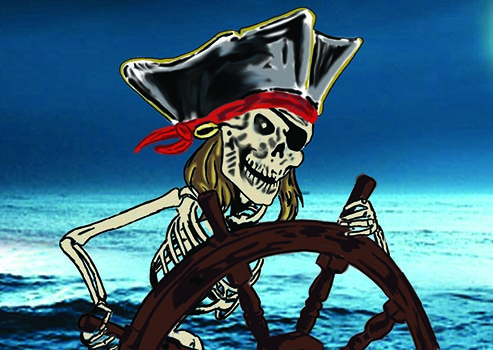September 19 is "officially" Talk Like a Pirate Day, and I want everyone to know that there is more to talking like a pirate than just throwing the occasional arrrgh into your daily conversation.

By Captain Ray
Published: September, 2016
September 19 is “officially” Talk Like a Pirate Day, and I want everyone to know that there is more to talking like a pirate than just throwing the occasional arrrgh into your daily conversation. The truth is, we all talk like pirates all the time because so many commonly used phases and expressions are thought to have nautical origins. Here are a few of them for your enjoyment:
In the days of the sailing navy, the diet of the regular seaman was extremely monotonous. The most common meat (when available) was salt pork, and it was usually prepared by boiling. After each meal, the greasy residues (called “slush,” most likely a corruption of “sludge”) were collected and used onboard as a lubricant. At the end of the voyage, soap and candle-makers bought what was remaining. The money from the sale was used to purchase small luxuries for the crew and is the origin of the term “slush fund.”
While we are still talking about food, onboard meals were served on square wooden plates, and from that we get the expression “a square meal.”
On sailing vessels, the lines that control a sail and vary its angle to the wind are called “sheets.” They are adjusted to balance the pressure of the wind in relation to the pivot point of the hull. When done properly, the vessel is easy to steer and control. If the wind is strong enough (or the crew incompetent enough) to lose control of one of these sheets, it becomes more and more difficult to steer, and the vessel is completely out of control by the time it is (or you are) “three sheets to the wind.”
Until early in the 19th century, the wives (and other female companions) of crew members were allowed to live aboard while the ships were in port. Sometimes this living arrangement would continue even when the ship put to sea. In order to gain a little privacy, these couples would set up housekeeping under temporary canvas traps rigged between the great guns. A child conceived or born in these circumstances (and often of dubious parentage) was referred to as “a son of a gun.”
When knights (and later army and naval officers) had the misfortune of being captured in battle, they had an advantage over the foot soldier or common seaman. Because they were gentlemen (and therefore wealthy), it was common practice for them to be ransomed. An agreement between the Dutch and the Spanish in the 17th century set this payment at 25 percent of the officer’s yearly salary. Hence the expression “to give quarter.”
As an island nation, England historically relied on its navy as its primary line of defense. Ship building was an important national interest. Certain tracts of wooded land were set aside as reserves, and the landowner was not permitted to cut down these trees. If, however, a tree was blown down by the wind, the owner was allowed to use it for his own purposes—because it was a “windfall.”
Most people know that the back of a boat is called the stern and the front the bow. There is, however, another term for the bow—or more precisely the vertical timber that forms the shape of the bow. Thus, any undertaking that had to be thoroughly or completely accomplished had to be done “from stem to stern.”
Ray Wichmann is a US SAILING-certified Ocean Passagemaking Instructor, a US SAILING Master Instructor Trainer, and a member of US SAILING’s National Faculty. He holds a 100-Ton Master’s License, was a charter skipper in Hawai’i for 15 years, and has sailed on both coasts of the United States, in Mexico, the Caribbean and Greece. He is presently employed as the Master Instructor at OCSC Sailing in the Berkeley Marina.

